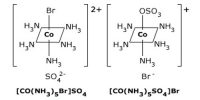Chlorophyll is a magnesium – porphyrin complex. The magnesium is at the centre of the modified porphyrin ring septeon (corrin). The oxidation state of magnesium is +2 (Mg2+). The modified porphyrin acts as the ligand.
There are several kinds of chlorophyll that vary slightly in their molecular structure.
In plants, chlorophyll ‘a’ is the pigment directly responsible for the transformation of light energy to chemical energy. Hence in plants, the green pigment chlorophyll helps photosynthesis. The conversion of atmospheric carbondioxide and atmospheric moisture into carbohydrate and molecular oxygen in the presence of sunlight, by the plant is called as photosynthesis. Chlorophyll acts as a light sensitiser in this important process.

Photosynthesis requires, in addition to chlorophyll, the help of four other metal complexes, a manganese complexes, two iron complexes and a copper complex.
All oxygenated animals take molecular oxygen through haemoglobin and release CO2. But chlorophyll helps in the conversion of atmosphere CO2 into molecular oxygen which act as a fuel for human cell.











